Pixar Shorts: The Adverts That Made Cinema History
In 1984 the Lucasfilm Computer Graphics Project released a short animated film called The Adventures of Andre and Wally B. The film lasted a total of 85 seconds and was unlike anything anyone had seen before. This was the start of what would later be named Pixar Animation Studios. Originally only meant to advertise the abilities of the Pixar computer, these shorts became Academy Award Winners and led to Pixar producing feature-length films. Over the course of nearly 30 years we have seen an amazing array of talent and innovation from Pixar with many of their greatest achievements coming from their original short films. Let’s take a look at this incredible journey and the successes the company has enjoyed since its humble beginnings.
Luxo Jr. (1986)
Where would Pixar be without its iconic desk lamp? This short follows the story of father and son lamps, Luxo Jr. and Luxo Sr. as they play with Pixar’s other infamous object, the ball. Little Luxo gets a bit too excited with his new toy and the inevitable happens, he bursts it. He looks to his Dad as if to say “fix it” but the ball can’t be mended. Luxo Jr. hangs his head and slowly hops off screen.Luxo Sr. then looks in surprise as his son returns with an even bigger ball and runs after it in the other direction. Luxo Sr. looks to the camera and shakes his head in disbelief.
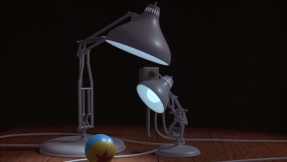 Luxo Jr. was the start of it all for Pixar. It was their first award winning film and had much more of a plot to it in comparison with The Adventures of Andre and Wally B. The overall CGI is fantastic for the time, especially in the use of light and shade, along with the movement of the lamps and how they interact with their surroundings. The way the Luxos communicate with the audience is a stroke of genius. They don’t have faces yet the way they move their ‘heads’ and ‘bodies’ is enough to let the audience know exactly what they are thinking. If a lamp extended his body quickly it showed surprise and if he hung his head it meant he was sad. Although the lamps are inanimate objects Pixar proved that with just a change in body position, the audience could feel connected. When the ball bursts the audience genuinely feels sorry for Luxo Jr. to the point that they forget he is just an object. This style of animation has been used widely since Luxo Jr. most notably in Aardman Animation’s Wallace & Gromit where the movement of Gromit’s eyebrows are enough to express his emotions and thoughts.
Luxo Jr. was the start of it all for Pixar. It was their first award winning film and had much more of a plot to it in comparison with The Adventures of Andre and Wally B. The overall CGI is fantastic for the time, especially in the use of light and shade, along with the movement of the lamps and how they interact with their surroundings. The way the Luxos communicate with the audience is a stroke of genius. They don’t have faces yet the way they move their ‘heads’ and ‘bodies’ is enough to let the audience know exactly what they are thinking. If a lamp extended his body quickly it showed surprise and if he hung his head it meant he was sad. Although the lamps are inanimate objects Pixar proved that with just a change in body position, the audience could feel connected. When the ball bursts the audience genuinely feels sorry for Luxo Jr. to the point that they forget he is just an object. This style of animation has been used widely since Luxo Jr. most notably in Aardman Animation’s Wallace & Gromit where the movement of Gromit’s eyebrows are enough to express his emotions and thoughts.
Pixar knows how much they owe to this early animation and have immortalised it by giving the lamp and ball various ‘cameo’ appearances in their later films, including the short film Red’s Dream and their first feature-length film, Toy Story. Luxo Jr. later found fame as part of the new Pixar logo which is still being used today.
Red’s Dream (1987)
Red’s Dream is the only Pixar original short not to receive any awards or nominations, which is slightly baffling as it is a beautifully haunting piece of cinema. Red’s Dream is also the only Pixar short that doesn’t leave you with a smile on your face but a rather sad acceptance that life does not always have a happy ending. Red’s Dream is about a unicycle sitting in the dusty sale section of a bike shop. It is night time and the rain is pouring down outside as Red slowly drifts off to sleep and dreams of performing with a clown in a circus. Red shows off his incredible juggling skills to a cheering crowd and basks in the glory of giving an outstanding performance, before waking up and realising that he has only been sleepwalking through the bike shop. He hangs his head before slowly making his way back to the dusty corner where he bangs his head on the wall and cuddles into to it to soothe himself back to sleep.
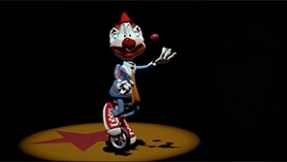 Red’s Dream is technically much more advanced that Luxo Jr. as there are a variety of different locations used in Red’s Dream including streets, the interior and exterior of the store and a circus which features a cameo from the infamous Pixar ball. There is also an improvement in the lighting in the film along with the rain outside which was rather impressive for the time that Red’s Dream was released. Although the animation was very advanced, this short may be responsible for creating a fear of clowns in a number of children, as the clown comes across as slightly terrifying. There are a couple of issues with the animation of the clown most notably the mouth, which seems to be glued into a permanent grin on his face giving him an almost sinister look. However, Red’s Dream is still a revolutionary piece of animation that I believe deserved more credit than it got.
Red’s Dream is technically much more advanced that Luxo Jr. as there are a variety of different locations used in Red’s Dream including streets, the interior and exterior of the store and a circus which features a cameo from the infamous Pixar ball. There is also an improvement in the lighting in the film along with the rain outside which was rather impressive for the time that Red’s Dream was released. Although the animation was very advanced, this short may be responsible for creating a fear of clowns in a number of children, as the clown comes across as slightly terrifying. There are a couple of issues with the animation of the clown most notably the mouth, which seems to be glued into a permanent grin on his face giving him an almost sinister look. However, Red’s Dream is still a revolutionary piece of animation that I believe deserved more credit than it got.
Tin Toy (1988)
Possibly the most defining short for Pixar was Tin Toy. This five minute short was responsible for saving Pixar Animation as at the time of Tin Toy’s release the company was facing tough financial strain. Tin Toy won the Academy Award for Best Animated Short (the first computer animated short to do so), grabbed the attention of Disney and was the basis for one of the most successful animated film series of all time, Toy Story. Tin Toy was also one of the most challenging films to animate and had multiple issues when it came to animating baby Billy.
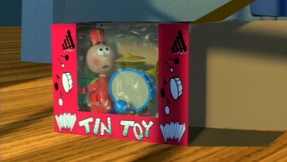 Tin Toy follows the story of Tinny, a one-man band toy who meets Billy, the baby that he has been given to. At first Tinny is excited to be played with but once he sees the way that Billy treats his other toys he becomes scared and tries to run away. He then hides under the sofa where he meets a whole group of terrified toys who have escaped Billy’s clutches. Tinny has the intention of joining the group but Billy falls over trying to chase him and begins to cry which makes Tinny feel guilty. Tinny then realises he must accept his fate and leaves the safety of the sofa to go to Billy to cheer him up. It works and Billy picks up a terrified Tinny and then sets him down. Tinny is still shaking when he looks up and sees that Billy, like most children has now chosen to play with the cardboard box that Tinny came in instead. Tinny is annoyed that Billy is not playing with him anymore and the film ends with Tinny desperately trying to win back Billy’s attention.
Tin Toy follows the story of Tinny, a one-man band toy who meets Billy, the baby that he has been given to. At first Tinny is excited to be played with but once he sees the way that Billy treats his other toys he becomes scared and tries to run away. He then hides under the sofa where he meets a whole group of terrified toys who have escaped Billy’s clutches. Tinny has the intention of joining the group but Billy falls over trying to chase him and begins to cry which makes Tinny feel guilty. Tinny then realises he must accept his fate and leaves the safety of the sofa to go to Billy to cheer him up. It works and Billy picks up a terrified Tinny and then sets him down. Tinny is still shaking when he looks up and sees that Billy, like most children has now chosen to play with the cardboard box that Tinny came in instead. Tinny is annoyed that Billy is not playing with him anymore and the film ends with Tinny desperately trying to win back Billy’s attention.
It is no secret that Tin Toy was an extremely controversial project for Pixar. At the time, Pixar was only producing the short films to advertise their computers and the company was struggling to break even. Steve Jobs, who owned Pixar from 1986 until its merger with Disney 20 years later, called a meeting to cut the budgets of various departments within the company. The Chief Creative Officer, John Lasseter, knew that with the new budget they would be unable to make Tin Toy. However, he was scared to ask for more money due to the hostility that existed towards the animation department from some of Pixar’s employees, who did not see the purpose of it. Eventually Lasseter plucked up the courage to ask and was granted the money with Jobs telling him only to “make it great.”
Tin Toy proved to be a much bigger challenge than originally anticipated, especially when it came to animating baby Billy. The animators could not get the face or the nappy to look the way they wanted but time was running out and even with the team rumoured to be sleeping under their desks to try and get the project finished on time for the SIGGRAPH convention, they failed and only had half of the film to show. Even though it was unfinished, Tin Toy still wowed the audience and demonstrated the abilities of CGI and how it could be used in the future to create feature-length films.
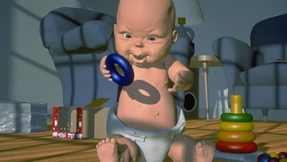 Watching Tin Toy in 2013 it is easy to spot the issues with the short, but what has to be remembered is that in 1988 Tin Toy completely changed the opinions of what experts thought was possible with CGI. Billy the baby showed the critics that humans could be created with CGI, even if there were issues with Billy and with his nappy having the look of stone rather than fabric. This along with the other smaller improvements to the graphics showed that CGI films were possible and raised the bar on what could be expected from computer animation.
Watching Tin Toy in 2013 it is easy to spot the issues with the short, but what has to be remembered is that in 1988 Tin Toy completely changed the opinions of what experts thought was possible with CGI. Billy the baby showed the critics that humans could be created with CGI, even if there were issues with Billy and with his nappy having the look of stone rather than fabric. This along with the other smaller improvements to the graphics showed that CGI films were possible and raised the bar on what could be expected from computer animation.
Lasseter and his team more than fulfilled Jobs’ request to make Tin Toy great and the film has gone down in cinema history with it being added to the National Film Registry in 2003. The film also attracted attention from Disney who then fought hard to get John Lasseter back by offering him a job as a director, Lasseter replied: “I can go to Disney and be a director or I can stay here and make history.”
Tin Toy paved the way for Pixar and influenced the story of the company’s first feature-length film Toy Story. Without Tin Toy who knows where Pixar would have been today.
Knick Knack (1989)
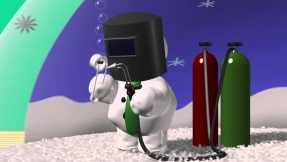 Knick Knack is a film about an unlucky snowman stuck in a snow globe. He lives at the other end of the shelf from the other knick knacks brought back from the lovely hot places that the house owners have visited. The snowman is desperate to be beside the other ornaments mostly because of the girl on the Sunny Miami souvenir which is his love interest in the film. Try as he might his luck just won’t change, even after trying to escape the globe with hammers, dynamite and power tools galore. After his attempt to escape with TNT, his snow globe falls off the shelf and he escapes mid-flight, only to land in a fish bowl. The cheeky little snowman seems to be a bit of a player in the end however, as landing in the goldfish bowl he finds a beautiful mermaid with whom he is also infatuated, but once again his efforts are squashed by his nemesis the snow globe. Knick Knack channels a Wylie Coyote feel to the short especially through the snowman’s use of TNT which only seems to cause injury to himself rather than his intended target of the snow globe.
Knick Knack is a film about an unlucky snowman stuck in a snow globe. He lives at the other end of the shelf from the other knick knacks brought back from the lovely hot places that the house owners have visited. The snowman is desperate to be beside the other ornaments mostly because of the girl on the Sunny Miami souvenir which is his love interest in the film. Try as he might his luck just won’t change, even after trying to escape the globe with hammers, dynamite and power tools galore. After his attempt to escape with TNT, his snow globe falls off the shelf and he escapes mid-flight, only to land in a fish bowl. The cheeky little snowman seems to be a bit of a player in the end however, as landing in the goldfish bowl he finds a beautiful mermaid with whom he is also infatuated, but once again his efforts are squashed by his nemesis the snow globe. Knick Knack channels a Wylie Coyote feel to the short especially through the snowman’s use of TNT which only seems to cause injury to himself rather than his intended target of the snow globe.
Knick Knack feels like a big jump in the ability of CGI from Tin Toy as it has multiple characters who each have their own style of movement. With Disney taking notice of Tin Toy and slowly putting plans in the works for Toy Story it appears that Knick Knack may have worked as a test piece for Toy Story by further pushing what was achieved in Tin Toy. Having an ornament cast would have given animators the chance to try out different techniques that would later be used in Toy Story but on a much smaller scale.
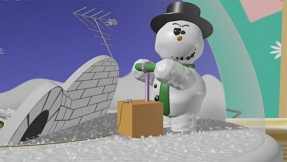 Knick Knack was relatively unheard of until it was re-released and screened before Finding Nemo in theatres in 2003 with some small changes. The original short while suitable for children, was not intended to be screened before a children’s film and there were some questions raised about the size of the female characters breasts. Ultimately the decision was made to change the appearance of the girls as John Lasseter felt that otherwise it would be inappropriate for young children.
Knick Knack was relatively unheard of until it was re-released and screened before Finding Nemo in theatres in 2003 with some small changes. The original short while suitable for children, was not intended to be screened before a children’s film and there were some questions raised about the size of the female characters breasts. Ultimately the decision was made to change the appearance of the girls as John Lasseter felt that otherwise it would be inappropriate for young children.
Knick Knack feels a lot more fun and relaxed compared to previous Pixar shorts. After the anguish suffered in Tin Toy, Pixar purposefully decided to make a much simpler short that did not require so much time to be spent struggling to animate complicated characters such as Billy the baby. The team had more fun and freedom animating Knick Knack as they had less pressure to prove themselves which had been required of them in Tin Toy. Knick Knack is cheeky, cartoonish and a little wacky and that works for it. It may not have been as revolutionary as Tin Toy but Knick Knack is just as enjoyable.
Geri’s Game (1997)
Geri’s Game was the second Pixar short film to win an Academy Award and showed a massive step forward in the abilities of computer animation. The short is a story about Geri who at first seems to be a lonely old man playing chess by himself in the park. Geri slowly lifts his highly magnified glasses with his shaking hands ready to begin his game of chess. He then struggles to his feet and shuffles round to the seat opposite without his glasses to play as the black player. Geri then enthusiastically slams his first pawn down as the black player and points and yells “ha!” to the empty seat. It appears that the black player acts as a younger Geri with energy and speed who is always one step ahead of the old, kind white player Geri. As the game nears to an end the ‘younger’ Geri has many pieces left with the ‘older’ Geri only having his king remaining. Older Geri sees an opportunity and fakes having a heart attack in order to beat the younger player by distracting him and switching around the board which wins him the game.
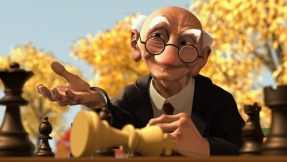 There are many theories as to why Geri is playing chess with himself: some say Geri is suffering from dementia and does not remember that he is playing against himself, others say that he has a split personality disorder like Dr Jekyll and Mr Hyde and others say that he is simply having fun trying to outsmarten his younger self.
There are many theories as to why Geri is playing chess with himself: some say Geri is suffering from dementia and does not remember that he is playing against himself, others say that he has a split personality disorder like Dr Jekyll and Mr Hyde and others say that he is simply having fun trying to outsmarten his younger self.
Geri’s Game showed a huge advancement in the abilities of human animation and the animation of fabrics. Geri was human however he was a cartoon impression of a human with an enlarged head and nose to add to the comic effect while still retaining human characteristics. Geri’s face and in particular the movement of his features and skin was a big improvement on what was seen in Pixar’s previous shorts. Geri looks much more human that Billy the baby from Tin Toy as his features move individually and his skin looks more life-like compared to Billy’s plastic looking skin. Geri’s Game came out only nine years after Tin Toy but it benefitted from the research into the movement of cloth which was done for the Toy Story films. Not only does the clothing move with Geri it also shows what type of fabric it is. The jacket moves in a way that would suggest a tweed material rather than something softer like silk. Geri’s Game is another one of the defining points in the history of computer animation.
For the Birds (2000)
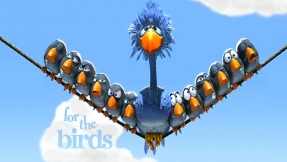 For the Birds is set on an electrical wire where a group of small birds are fighting. As they peck at one another a loud caw from a large, bedraggled looking bird interrupts them. Seeing the new bird as a source of comedy, the small birds poke fun at him by impersonating his scruffy appearance and apparent lack of intelligence. Completely unfazed, the large bird flies towards the birds and plonks himself down in the middle of the group, which causes the wire to bend. The small birds are even more annoyed now and one pesky little fellow jabs his beak into the side of the big bird causing him to fall upside down, leaving only his toes to grip the wire. Ceasing the opportunity to bully the big bird further, two birds begin to peck at his toes with much encouragement from the rest of the group, including the big bird who seems to see this as a bit of a game. In a matter of time all but one toe is holding the big bird to the wire when suddenly the little birds realise that as soon as the big bird lets go they will shoot up into the air. They shout at the other birds to stop but it’s too little, too late. On returning to the ground all the little birds have lost their feathers and are now running around naked, much to the amusement of the big bird who offers one a leaf to cover himself while he rolls about laughing at them.
For the Birds is set on an electrical wire where a group of small birds are fighting. As they peck at one another a loud caw from a large, bedraggled looking bird interrupts them. Seeing the new bird as a source of comedy, the small birds poke fun at him by impersonating his scruffy appearance and apparent lack of intelligence. Completely unfazed, the large bird flies towards the birds and plonks himself down in the middle of the group, which causes the wire to bend. The small birds are even more annoyed now and one pesky little fellow jabs his beak into the side of the big bird causing him to fall upside down, leaving only his toes to grip the wire. Ceasing the opportunity to bully the big bird further, two birds begin to peck at his toes with much encouragement from the rest of the group, including the big bird who seems to see this as a bit of a game. In a matter of time all but one toe is holding the big bird to the wire when suddenly the little birds realise that as soon as the big bird lets go they will shoot up into the air. They shout at the other birds to stop but it’s too little, too late. On returning to the ground all the little birds have lost their feathers and are now running around naked, much to the amusement of the big bird who offers one a leaf to cover himself while he rolls about laughing at them.
![]() For the Birds was screened before Monsters Inc. in cinemas but was released a year earlier at the Annecy International Animated Film Festival. Monsters Inc. used new techniques to animate Sulley’s fur and these are also demonstrated in the feathers of the birds. Pixar realised that to make Sulley’s fur as realistic as possible they would need to invest in new equipment. Monsters Inc. had more than double the amount of computer processers than Toy Story 2 had and more than 17 times the processors of Toy Story. This investment allowed For the Birds to reach its full potential and it benefited greatly from the research that had gone into animating Sulley’s fur. Each bird’s feather moves independently just like a real bird’s would. When the birds are stretching and shaking themselves at the start of the film you can see the shadows and movement of the feathers which looks as real as could be expected given it is computer animated. This is different to previous Pixar shorts such as Geri’s Game where Pixar had not yet managed to correctly show shadows in hair.
For the Birds was screened before Monsters Inc. in cinemas but was released a year earlier at the Annecy International Animated Film Festival. Monsters Inc. used new techniques to animate Sulley’s fur and these are also demonstrated in the feathers of the birds. Pixar realised that to make Sulley’s fur as realistic as possible they would need to invest in new equipment. Monsters Inc. had more than double the amount of computer processers than Toy Story 2 had and more than 17 times the processors of Toy Story. This investment allowed For the Birds to reach its full potential and it benefited greatly from the research that had gone into animating Sulley’s fur. Each bird’s feather moves independently just like a real bird’s would. When the birds are stretching and shaking themselves at the start of the film you can see the shadows and movement of the feathers which looks as real as could be expected given it is computer animated. This is different to previous Pixar shorts such as Geri’s Game where Pixar had not yet managed to correctly show shadows in hair.
For the Birds won the Academy Award for Best Short Film in 2002, Monsters Inc. was nominated for Best Animated Film in that year as well but lost out to Dreamworks’ Shrek.
Boundin’ (2003)
Boundin’ was Pixar’s first short that was fully narrated rather than acted out through mime and small squeaks or sounds. Boundin’ tells the story of a lamb and his friends who marvel at his beautiful coat and dancing ability. However, when summertime arrives, the farmer shears his fleece and the other animals laugh at him as he no longer looks pretty. A jackalope then hops along and tells the lamb not to feel down as everyone has good times and bad times and shows him that by bounding instead of dancing he can still have fun.
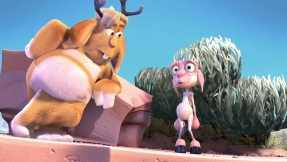 Boundin’ felt like a completely different approach to the usual Pixar short mainly due to the narration and music but it also seemed that it was more geared towards younger children, rather than to be enjoyed by all. Boundin’ used the techniques from Monsters Inc. to animate the fur and fleeces of the animals and also showed development in the animation of water with streams, bubbles, leaping fish and small waterfalls making an appearance. There were also dust clouds from the jumping animals which would have allowed the animators to experiment with how to create dust clouds before extensively using them in the film Cars which came out two years later. Boundin’ is a fable and its moral is no matter what you may look like on the outside it’s what on the inside that counts. This is different to other Pixar shorts, even those that also had morals in the stories (a similar message could be taken from For the Birds) as they were delivered in a more subtle way rather than making the message as obvious as is seen in Boundin’.
Boundin’ felt like a completely different approach to the usual Pixar short mainly due to the narration and music but it also seemed that it was more geared towards younger children, rather than to be enjoyed by all. Boundin’ used the techniques from Monsters Inc. to animate the fur and fleeces of the animals and also showed development in the animation of water with streams, bubbles, leaping fish and small waterfalls making an appearance. There were also dust clouds from the jumping animals which would have allowed the animators to experiment with how to create dust clouds before extensively using them in the film Cars which came out two years later. Boundin’ is a fable and its moral is no matter what you may look like on the outside it’s what on the inside that counts. This is different to other Pixar shorts, even those that also had morals in the stories (a similar message could be taken from For the Birds) as they were delivered in a more subtle way rather than making the message as obvious as is seen in Boundin’.
One Man Band (2005)
One Man Band returned to the more familiar Pixar style of mime and music which often achieves a more comical result than including dialogue. This film takes place in a square in Italy where a musician is playing tediously to the empty streets until he spots a young girl with a shiny penny walking to the fountain to make a wish. The musician instantly perks up and catches the girl’s attention with his energetic music and charisma. Just as the girl is about to put the penny in the musicians cup, another musician appears who also is a one man band but instead of drums, trumpets and clarinets he has instruments such as violins, a piano and a lute. Both musicians try to outdo one another becoming louder and more flamboyant in order to win the little girls coin. They close in on her at the fountain which scares her and she drops the coin which falls down the drain. Instead of crying the girl demands that the musicians pay her back. The musicians say they have no money so instead she requests a violin from one musician and a tin can from the other. She then performs an outstanding piece on the violin and a villager to drops a large bag of gold into the can. She then teases the musicians with two coins before throwing the coins onto the top level of the fountain out of the musicians reach.
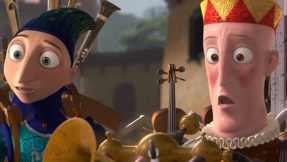 One Man Band didn’t really bring anything new to animation technically but as usual there were some subtle improvements. There was an improvement with the texture of the clothing as it was easier to tell what fabric it was supposed to be, whether it was the coarse fabric of the peasant girl or the luxurious velvet of the violinist. One Man Band was a welcome return to comedy for Pixar and is still the only Pixar short with more than one human character.
One Man Band didn’t really bring anything new to animation technically but as usual there were some subtle improvements. There was an improvement with the texture of the clothing as it was easier to tell what fabric it was supposed to be, whether it was the coarse fabric of the peasant girl or the luxurious velvet of the violinist. One Man Band was a welcome return to comedy for Pixar and is still the only Pixar short with more than one human character.
Lifted (2006)
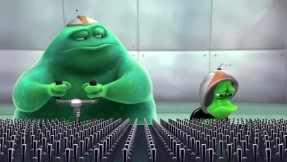 Lifted follows a little alien named Stu who is being assessed on his ability to abduct humans from their homes. Unfortunately for him it does not go well and every button he touches seems to make the situation worse. Eventually his instructor has to step in to save him and Stu hangs his head in shame. The instructor then feels guilty and lets Stu fly the spaceship home, which only results in Stu crashing the spaceship into the house of the man he was trying to abduct destroying everything but his bed.
Lifted follows a little alien named Stu who is being assessed on his ability to abduct humans from their homes. Unfortunately for him it does not go well and every button he touches seems to make the situation worse. Eventually his instructor has to step in to save him and Stu hangs his head in shame. The instructor then feels guilty and lets Stu fly the spaceship home, which only results in Stu crashing the spaceship into the house of the man he was trying to abduct destroying everything but his bed.
Lifted can appeal to many people due to how easy it is to relate to Stu. Those people who have sat their driving test will feel particularly sympathetic. Pixar has mastered the art of telling a story without dialogue, which works brilliantly in this film as the audience can add in their own script and perhaps remember a time when they were in a similar situation. As Pixar shorts were starting to be released more frequently there is a less noticeable improvement in the CGI. However, there are still some small tweaks which add to the overall effect. Lifted was one of the first Pixar shorts where the audience could really relate to the story. Everyone to some extent has had an experience like Stu whether it be in an exam or not which makes it different to other shorts by making the audience reflect on their own experiences.
Presto (2008)
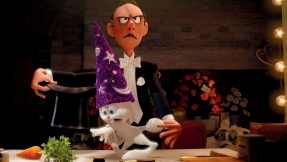 Possibly one of the greatest shorts from Pixar is Presto. The story follows magician Presto and his bunny Alec Azam as they perform a magic act in front of a large audience. Presto is running late for the performance and in doing so forgets to feed Alec a carrot which does not please him in the slightest. Therefore Alec decides to take his revenge by being extremely uncooperative throughout the act which contains two hats (one that looks very familiar) that are magically linked together.
Possibly one of the greatest shorts from Pixar is Presto. The story follows magician Presto and his bunny Alec Azam as they perform a magic act in front of a large audience. Presto is running late for the performance and in doing so forgets to feed Alec a carrot which does not please him in the slightest. Therefore Alec decides to take his revenge by being extremely uncooperative throughout the act which contains two hats (one that looks very familiar) that are magically linked together.
Alec uses a variety of methods to wind Presto up such as electrocuting him and putting his fingers in mousetraps. This type of humour is like that found in classic cartoons such as Tom and Jerry and Looney Tunes.
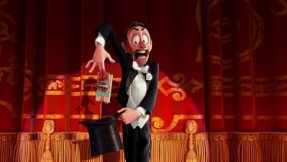 The short is very similar to the episode of Tom and Jerry called The Cat Concerto in which Jerry steals the show by performing an elaborate piece on the piano strings. Tom tries to injure Jerry to stop him showing him up but this only makes Jerry angry. Jerry then demonstrates his talent playing an extremely fast piece while an exhausted Tom tries to keep up with him, which is exactly what happens in Presto. At the end of Presto, Alec saves his partner from death by pulling him out of the path of a falling grand piano which could be seen as a tribute to the classic Tom and Jerry episode.
The short is very similar to the episode of Tom and Jerry called The Cat Concerto in which Jerry steals the show by performing an elaborate piece on the piano strings. Tom tries to injure Jerry to stop him showing him up but this only makes Jerry angry. Jerry then demonstrates his talent playing an extremely fast piece while an exhausted Tom tries to keep up with him, which is exactly what happens in Presto. At the end of Presto, Alec saves his partner from death by pulling him out of the path of a falling grand piano which could be seen as a tribute to the classic Tom and Jerry episode.
Presto showed developments in the abilities of the Pixar team with multiple new techniques being brought together in the one film. There were smoke clouds which were developed in Boundin’, as well improvements in spotlighting which was demonstrated in Lifted. The biggest improvement was with scenery in the short as it takes place in a beautiful, large theatre. A set this intricate was not thought possible until the door chase scene in Monsters Inc. Even though these scenes were very difficult to animate it allowed Pixar to push the bar higher on what could be achieved with CGI.
Partly Cloudy (2009)
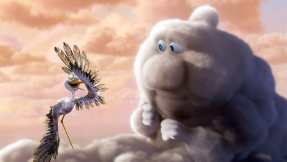 Where did the storks come from when they delivered Dumbo? Well Partly Cloudy seems to answer that as this short takes place in the baby factory in the sky. The pink clouds create the cute babies such as puppies, kittens and chicks. However, there is one darker cloud that can only produce some of the more ferocious babies in the world including crocodiles, porcupines and sharks. After making the dangerous little critters it is up to one stork to deliver them, who strangely resembles Nigel the pelican from Finding Nemo. The stork endures being bitten, scratched and rammed (literally) in the chest before he starts to think of leaving the dark cloud. He flies to the pink cloud above which makes the grey cloud feel rejected and angry. He creates a thunderstorm before crying hysterically. The stork returns and shows him a helmet that he had the other cloud make for him so he can carry the fierce babies without getting hurt. The cloud is overjoyed and hands him the electric eel he has just made which still manages to injure the stork when he is wearing the protective gear.
Where did the storks come from when they delivered Dumbo? Well Partly Cloudy seems to answer that as this short takes place in the baby factory in the sky. The pink clouds create the cute babies such as puppies, kittens and chicks. However, there is one darker cloud that can only produce some of the more ferocious babies in the world including crocodiles, porcupines and sharks. After making the dangerous little critters it is up to one stork to deliver them, who strangely resembles Nigel the pelican from Finding Nemo. The stork endures being bitten, scratched and rammed (literally) in the chest before he starts to think of leaving the dark cloud. He flies to the pink cloud above which makes the grey cloud feel rejected and angry. He creates a thunderstorm before crying hysterically. The stork returns and shows him a helmet that he had the other cloud make for him so he can carry the fierce babies without getting hurt. The cloud is overjoyed and hands him the electric eel he has just made which still manages to injure the stork when he is wearing the protective gear.
Partly Cloudy was released with Up which required extensive research into animating clouds and sky. This reverts back to Pixar’s old release calendar where they would develop a short film either at the same time or a few years earlier such as with For the Birds and Monsters Inc. which would allow the animators the time to perfect their techniques before applying them to a feature length film. The texture and movement of the clouds is very life-like but it still manages to maintain its animated charm. This short is both heart-warming and hilarious which works well and feels like a good mix of previous Pixar shorts taking the humour from For the Birds and crossing it with the morals from Boundin’.
Day & Night (2010)
Day & Night demonstrated completely different style compared to other Pixar films. Day & Night was the first Pixar original short to use a mixture of 2D and 3D animation in the one film. The story follows two characters Day and Night as they stumble across one another in a black void. At first they are wary of each other and become jealous of what the other one can do which causes them to fight. As Day is knocked out Night notices a girl sunbathing inside Day, but when he steps into the same spot that Day was in the girl has vanished and all is left is her rubbish from the day. Day decides to cheer Night up by showing him an entire pool party of girls, which leads to Day and Night no longer being scared or jealous of each other and they are able to appreciate the differences between them. They go on to show each other the best parts of day and night including rainbows, fireworks and casinos until Day stumbles onto a radio broadcast which Night wants to hear. They both listen to a speech by Dr. Wayne Dyer who talks about fear of the unknown. They then look at each other and realise that this relates to them. As the sun rises and sets in each of the characters they switch places, Day becomes Night and Night becomes Day.
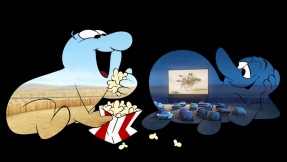 Day and Night’s emotions are represented by different elements of their time, if Day is happy he shows a rainbow while Night displays fireworks and the sound is used in a similar way. When Day rubs his eyes they squeak like a bike chain and you can see a cyclist travelling through him and when Night laughs he quacks like the ducks that are walking through him. This is a simple idea but it demonstrates a different technique that is very effective in this short that heavily relies on the environment to tell the story.
Day and Night’s emotions are represented by different elements of their time, if Day is happy he shows a rainbow while Night displays fireworks and the sound is used in a similar way. When Day rubs his eyes they squeak like a bike chain and you can see a cyclist travelling through him and when Night laughs he quacks like the ducks that are walking through him. This is a simple idea but it demonstrates a different technique that is very effective in this short that heavily relies on the environment to tell the story.
The fear of the unknown is the theme of this short and it was based on ideas from lecturer Dr. Dyer who provided the voice in the film from a lecture he gave in the 70’s. He spoke of how the unknown does not always have to be something to be afraid of but it can also be beautiful. Like many recent Pixar shorts Day & Night has a nice moral to it: don’t fear new things, learn to appreciate what others can bring to your life and work together to enhance your experience.
The style of the 2D animation is very similar to the Pink Elephants on Parade scene in Dumbo and the Day and Night characters have a similar build and style of movement. The way the Pink Elephants are animated is also replicated and developed in Day & Night. In Dumbo the elephants only display different colours and patterns within their bodies however in Day & Night there are CGI scenery and characters. The facial animation of Day and Night is very Disney-like and in some ways looks similar to the faces of the Seven Dwarfs from Snow White.
Although Pixar did not win an Academy Award for this short, they presented a new side of the studios and highlighted their ability to be risky and innovative whilst always challenging themselves to try new things.
La Luna (2011)
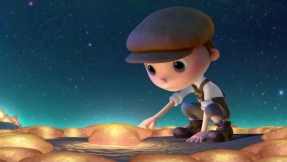 La Luna is one of the ‘sweeter’ Pixar shorts that leaves you thinking “that was nice” rather than completely blowing you away but it is still a good short nonetheless. La Luna features a little boy on a boat trip with his Dad and Granddad. As they reach the middle of the sea the Granddad presents the boy with a cap. Dad and Granddad argue about how Kid should wear his cap with none taking into consideration how Kid wants to wear it. The moon rises and Dad pulls a ladder out from the boat, gives the boy an anchor and a rope and instructs him to climb to the moon. Once he reaches the moon he sees the whole surface is covered in shining stars and is joined by his Dad and Granddad who then argue again about which broom the boy should use. All of a sudden a giant shooting star crashes into the moon and the men are left trying to dig it up out of the moon’s surface. The boy then turns his cap back to front, climbs the star and taps it with a hammer causing it to shatter into hundreds of tiny stars. Kid picks up a rake and helps his family to push the stars into forming a crescent shaped moon.
La Luna is one of the ‘sweeter’ Pixar shorts that leaves you thinking “that was nice” rather than completely blowing you away but it is still a good short nonetheless. La Luna features a little boy on a boat trip with his Dad and Granddad. As they reach the middle of the sea the Granddad presents the boy with a cap. Dad and Granddad argue about how Kid should wear his cap with none taking into consideration how Kid wants to wear it. The moon rises and Dad pulls a ladder out from the boat, gives the boy an anchor and a rope and instructs him to climb to the moon. Once he reaches the moon he sees the whole surface is covered in shining stars and is joined by his Dad and Granddad who then argue again about which broom the boy should use. All of a sudden a giant shooting star crashes into the moon and the men are left trying to dig it up out of the moon’s surface. The boy then turns his cap back to front, climbs the star and taps it with a hammer causing it to shatter into hundreds of tiny stars. Kid picks up a rake and helps his family to push the stars into forming a crescent shaped moon.
There has been more work done with the animation of the water and the effects of the stars in this short but really overall the graphics have remained consistent with previous shorts. The standard of CGI is very high and with the Pixar shorts coming out in quick succession there isn’t as great a difference in the graphics as seen in earlier years. Whilst not being one of Pixar’s most memorable shorts, La Luna is still a nice short worthy of the Pixar name.
The Blue Umbrella (2013)
The Blue Umbrella is the most recent short to be released by Pixar and it was screened before this summer’s big hit, Monsters University. It follows two umbrellas as they fall in love during stormy weather at rush hour in a bustling city. The two umbrellas become separated when their owners take two different routes home from work. The blue umbrella decides he can’t leave the red umbrella and with the help of many of his city friends including, barriers, electric signs and drains he manages to be reunited with his love.
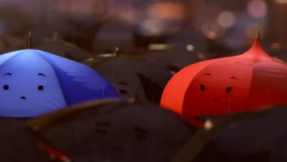 The Blue Umbrella has a similar feel to La Luna with a story that leaves you with a warm heart rather than laughing hysterically which is nice for a change from Pixar’s usual shorts. Unlike La Luna however there are some further advances in animation techniques in The Blue Umbrella. Pixar had again updated their systems prior to Monsters University which this short has benefitted from as there are improvements in the lighting throughout the film. The weather plays an important part in this short with constant wind and rain and the umbrella appears to have a more natural movement through the air than has been seen previously. The Blue Umbrella shows that Pixar is continuing to improve its graphics which is vital for the future of animated cinema, especially when animators are faced with something they have never had to animate before.
The Blue Umbrella has a similar feel to La Luna with a story that leaves you with a warm heart rather than laughing hysterically which is nice for a change from Pixar’s usual shorts. Unlike La Luna however there are some further advances in animation techniques in The Blue Umbrella. Pixar had again updated their systems prior to Monsters University which this short has benefitted from as there are improvements in the lighting throughout the film. The weather plays an important part in this short with constant wind and rain and the umbrella appears to have a more natural movement through the air than has been seen previously. The Blue Umbrella shows that Pixar is continuing to improve its graphics which is vital for the future of animated cinema, especially when animators are faced with something they have never had to animate before.
In less than 30 years we have seen the ability of CGI increase at an alarming rate, from being unable to animate a baby’s nappy to seeing an umbrella fly through the air in the middle of a rainstorm. Pixar shorts have the ability to appeal to all ages for a number of reasons and everyone will have their own personal favourite. The popularity of the original shorts caused Pixar to look into expanding the use of short films and there are now some great feature-related shorts including Mike’s New Car from Monsters Inc., Jack-Jack Attack from The Incredibles and a series of three shorts related to the Toy Story films. What would be good to see in the next few years from Pixar would be another cartoon style comedy as For the Birds is a personal favourite of mine and there has not been a pure comedy short since Partly Cloudy in 2009.
These shorts were only meant to advertise computers but instead led to the creation of an award winning animation studio. The Pixar original shorts always have the ability to make people smile and have shown that even with a limited run-time, the magic of cinema can be still be achieved.
What do you think? Leave a comment.
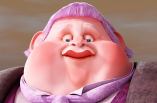
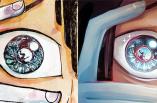
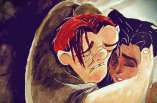

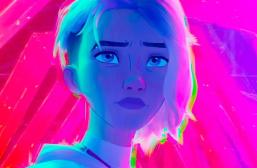
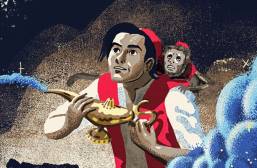
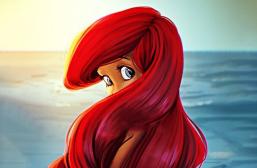
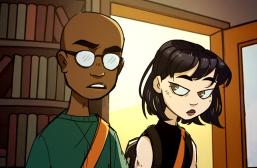
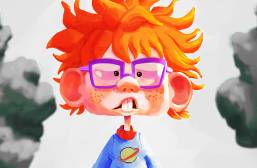
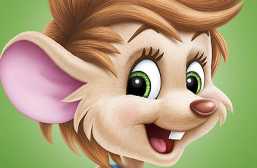
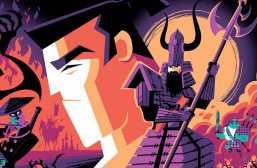
I remember For The Birds back from when I was 4 and I used to watch this on the VCR!
That was also the first short I remember seeing when I was seven, possibly why it is still one of my favourites.
We call it VHS.
I will start off by giving you some praise for a very comprehensive article, it must have taken you some time to write it. Great!
I saw The Blue Umbrella when I watched Monsters Uni and by the end I was asleep and practically thought the movie was ok but the umbrella short was perfect!
Thank you, it did take a lot longer than I originally anticipated but I had a lot of fun writing it.
I enjoyed Monsters University but I think Monsters Inc. was better, The Blue Umbrella is a great Pixar short.
This was a fun article.
I have always liked the shorts more than the films, but i have not seen some of the newer films, so I am behind on the shorts.
Knick Knack is my favorite by a wide margin.
Thanks!
I have as well, I think they show just how great Pixar is. Knick Knack is definitely up there with my favourites as well.
La Luna is my favorite. The style of Miyazaki lives on with this amazing director/writer. Go pixar! Uplifting, human, gentle and magical, while encouraging courage and being yourself – the best kind of inspiration for children and adults alike. Bravo!
Just watched it (after reading this comment) and I was delighted to see a film inspired by Italo Calvino’s stories! Lovely work. The people are really cute, and the golden stars look so pretty, almost crispy and edible.
Btw, it was incredibly hard to find this online!
That’s very true, I was slightly mesmerised by the stars! It’s a different style from the usual Pixar but you’re right it still manages to appeal to all ages.
I knew nothing about these short adverts and I am a big animation consumer. Very useful info, I am ready to hunt these down.
Thank you
They are great shorts but unless you have managed to stumble upon them before a screening of one of Pixar’s films it would be easy enough to not know about them. Enjoy watching them!
I am an animator and one day I hope to work for Pixar whether it be for animation, story-boarding or even just an internship. I find their work highly inspiring and creative, who doesn’t.
I definitely find them inspiring as well, I would love to work for them one day too, unfortunately I am terrible at art. Good luck to you!
They have had many hits and misses when it comes to the tiny film genre, but here is no denying that they have landed a spot in the greatest animation producers along with Disney.
They have, I think everyone has their favourites and what some people like others dislike. They are definitely up there with Disney, especially after Toy Story.
Fun article – I’d forgotten about Red’s Dream, Knick Knack and Tin Toy, but since reading this I remember watching them when I was a kid and them sticking somewhere in my subconscious – I think that’s what makes Pixar’s work truly stand out from the crowd. Of the newer ones, Presto is my favourite: technically innovative and delightful as well as having a heart and a sense of humour.
Good stuff!
Thank you!
Yes Pixar definitely stands out. I hadn’t seen some of the earlier ones before writing this and I started off by watching For the Birds and then Luxo Jr. both very funny shorts, I then watched Red’s Dream and found it very emotional, I think Red’s Dream would be my favourite of the older ones.
Presto is one of my favourite newer ones, I grew up watching Tom and Jerry so it really appeals to me. It is much more complex, animation wise, than some of the other newer ones.
I’ve spent ages trying to find Boundin’. Reading this took me back to some of the shorts that I watched when being a child.
Thank you, I felt the same writing it, Pixar is great at reminding you of happy childhood memories.
I love the message behind ‘Day & Night’.
Embrace our differences.
We all share common ground.
Might as well make the best of it.
–Toby
I do as well, very relevant in today’s world. It is a short that really makes you look at your life and that makes it great.
I love pixar films but have never watched any of the shorts. After this I definitely will, great article!
Thank you! They are definitely worth a watch
wow neat and complete post!
Thanks, glad you enjoyed it!
Is there like a DVD/Bluray box available? I want to watch these!
There are two volumes available both called Pixar Short Films Collection and then volume one or two. One has The Adventures of Andre and Wally B – Lifted and two has Your Friend the Rat – Time Travel Mater, there are a lot of the feature related films on volume two but a few originals are on there as well.
Not a Pixar short but I still remember the sequence that really blew me away when I first saw it. In Toy Story 2 when Woody crawls over Al’s face to get his missing arm and every bit of stubble on Al’s face moves individually as he breathes while sleeping. Incredible at the time though not so amazing now it showed a big step in animation. Good article!
Thank you. That is a great scene I think for their feature-length films the Toy Story series and Monsters Inc. showed the most development.
Lovely article – I got a bit nostalgic reading about the earlier shorts! It’s great to see them getting some well-deserved appreciation.
Thank you! Glad you enjoyed it, I definitely felt nostalgic writing it, especially when it came to For The Birds.
Great article, I love the old ones as much as the new, and all of them have the same captivating emotions that could only be described properly within the medium by Pixar.
Thank you, Pixar is great at getting the audience involved in their films, you really end up caring about the characters.
This is a fun rundown! I actually think the words “A Pixar Short” carry as much weight as “A Pixar Film” these days. I always look forward to the shorts just as much (if not more) than I do the films and I’ve found that in recent years the shorts actually have the edge on the films in terms of Pixar’s trademark ingenuity. They’re such a classic example of visual storytelling, a kind of throwback to the silent era and the “golden age” shorts that made movie-going such a visual experience. These shorts are so refreshing when compared to the animation out there that relies so much on dialogue (not to mention pop culture references).
Thank you. I always look up to see whether a Pixar film will have a short attached to it I’m the same I often look forward to the shorts just as much as the films. That’s a great point and is probably why it appeals to a lot of people it’s a very classic style that everyone can appreciate.
I loved this article. It was such a lovely, informative article on some of my favourite animations. Pixar does wonderfully with their shorts and I have never hated one, ever. They are light, funny, and sometimes heart-wrenching — all in the space of a couple of minutes. My absolute favourite is Geri’s Game, one of the first shorts I watched before my favourite Pixar movie ‘A Bug’s Life’. A fun read, Amy!
Thank you Abby! I agree I have never hated a Pixar short, even the ones I may not like as much as others I can still enjoy. A Bug’s Life is a great movie.
The guys at Pixar don’t even know how to make something uninteresting
That is very true!
Most of the world knows Pixar at least as well for its animated shorts as for its longer works.
Thanks for this extensive roll sheet on some of the best highlights. I missed the “Ice Age” trailer short(s?) with Scrat the squirrel – I believe one was called “Gone Nutty” (2002), and I still remember how Pixar’s use of a revolutionary physics engine technique in the bouncing descent of the acorn captivated an entire cinema audience.
That is true they have proved to be very popular. I would have included Scrat’s shorts if I was doing an overview do all shorts however, this one just covered Pixar and the Ice Age franchise is owned by Blue Sky. They are also great mini-movies though!
Aww I remember For The Birds from when I was little! Love Pixar’s shorts, they’re so damn cute 🙂
I know! I think I love them just as much if not more than some of their full length movies.
Thank you for your article! As a Pixar fan, I’ve just spent over an hour watching all those little clips! I remembered that I was pleasantly surpised by Partly Cloudy when I went to see Up! a few years ago, such a tender story
Thank you for reading! I always love an unexpected Pixar short, Partly Cloudy wasn’t one I had seen before writing this but I certainly class it as one of my favourites now.
I love them all.
So do I, each for a different reason than the rest.
This was a great article, covers a big scope. The shorts definitely captivate the audience, and create great emotions. My favorite by far is Day and Night, simply because it blends so many techniques together!
Thank you! I agree from a technical point of view Night and Day wins it for me.
I never knew that Pixar made this shorts already before the 2000s! The only ones I’ve seen are those after that, my favourite being Lifted. You’re absolutely right; to someone who had to take the driver’s license test four times (no kidding), it’s a very relatable movie.
All of these shorts are wonderful and you did a very good job at pointing out their individual achievements – great article!
Thank you! I knew they had made one or two but didn’t know there were that many and I didn’t realise they were initially used to advertise software, so it was a big surprise for me too! Yes I can certainly relate to Lifted as well when I was learning to drive, it’s not as easy as it looks!
Very well written. I enjoyed reading about how each short has improved Pixar’s animation technique over time. It really is amazing how a celebrated art form started out as an advertisement for a computer. I recently picked up the Pixar Collections I and II, so this article has provided some good background knowledge before I start watching the DVDs.
Pixar shorts bring back so many fond memories. I think I still have a few of the older shorts on my VHSs.
The thing I love most about Pixar is that at this time, they would be able to release many okay films and make a lot of money that way, as many other film studios have done in the past, but they choose not to. Instead of resting on past accomplishments, they continue to push the boundaries of animation, which can be seen clearly in their shorts.
Before reading this article, I had seen all of their shorts except for Blue Umbrella. Now Blue Umbrella has quickly become one of my favorite love stories, and not just among animated shorts. That’s the beauty of Pixar shorts. Not only do they stand out in their own field, but they often stand out among all types of media.
Loved the article by the way. I got to be reminded of the best things of some of my favorite bits of entertainment.
Wonderful article, brought back memories of some of my favourite shorts ever!